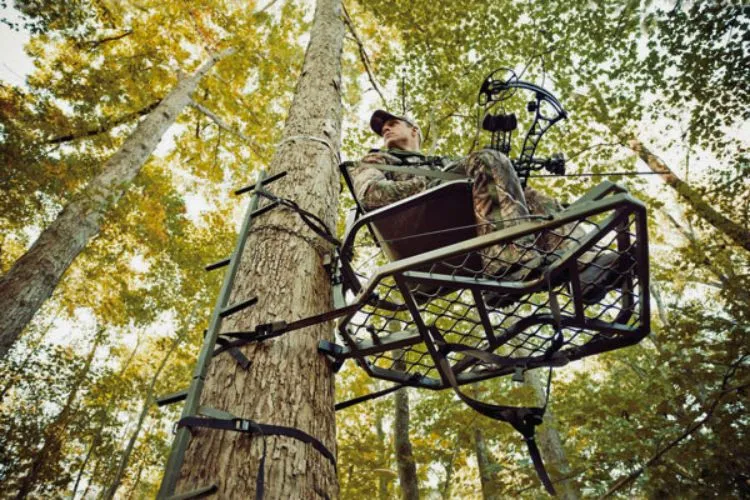In the world of deer hunting, stealth is not just a skill; it’s an art form. Hunters go to great lengths to blend into their environment, minimize noise, and mask their scent—all in the hope of getting a clear shot at their game.
Among the various strategies employed, the use of ladder stands has become increasingly popular. However, this raises an important question: Do ladder stands spook deer?
This article aims to delve into this query, exploring deer behavior, the characteristics of ladder stands, and how the two interact in the complex dance of hunting.

Do Ladder Stands Spook Deer?
Ladder stands can potentially spook deer if not used correctly, as deer are sensitive to changes in their environment and unfamiliar objects. However, the impact can be minimized through strategic placement, proper camouflage, and setting up the stand well before hunting season to allow deer to become accustomed to its presence.
It’s also crucial to minimize noise and human scent. If hunters consider these factors and employ stealthy practices, ladder stands do not necessarily spook deer more than other types of stands. In fact, when used correctly, they can provide an effective platform for hunting without significantly disturbing deer behavior.
Understanding Deer Behavior
To understand how ladder stands may affect deer, one must first grasp the basic senses of these animals. Deer rely heavily on their sight, hearing, and smell to detect predators and danger. They are particularly adept at noticing changes in their environment, which can trigger a cautious or evasive response.

Understanding these natural instincts is crucial for hunters aiming to remain undetected. Knowing how deer perceive threats enables hunters to make informed decisions about stand placement and hunting practices.
Overview of Ladder Stands
Ladder stands consist of a platform and a seat attached to a ladder, which is then secured to a tree. They offer hunters an elevated vantage point, increasing visibility and range while aiming to reduce their scent’s reach on the ground level.
While ladder stands provide several advantages, such as comfort and stability, they are not without their potential drawbacks. Their size and the noise associated with setting them up can be detrimental if not managed correctly.
Factors Influencing Deer Reaction to Ladder Stands
Several elements can affect how deer react to the presence of ladder stands. The stand’s location is critical; those placed near well-used trails or feeding areas may be more readily accepted by deer.

The length of time the stand has been in place also plays a role; deer may become habituated to the stand over time, especially if it is introduced well before the hunting season begins. Additionally, the amount of human activity around the stand, including the hunter’s approach and departure, can influence deer behavior.
Strategies to Reduce Spooking Deer with Ladder Stands
Minimizing the likelihood of spooking deer involves several strategic approaches. Proper placement is crucial; selecting a location that blends naturally with the environment can help.
Camouflaging the stand, using scent blockers, and minimizing noise are all effective strategies. Additionally, setting up the stand well in advance of the hunting season gives deer time to adjust to its presence.
Case Studies and Expert Opinions
Research and anecdotal evidence provide insight into the best practices for using ladder stands. Studies focusing on deer behavior in relation to new objects in their environment can offer valuable guidelines.
Experienced hunters, through trial and error, have also identified effective strategies for using ladder stands without alarming deer.
Best Practices for Using Ladder Stands
Selecting the right location involves considering wind direction, natural cover, and deer traffic patterns. Once a suitable spot is chosen, setting up the stand quietly and efficiently is paramount.

Regular maintenance ensures the stand remains safe and noise-free. When using the stand, hunters should approach and leave as quietly as possible, preferably at times when deer are less active.
You may also read: How to Use Multi Purpose Ladder?
Frequently Asked Questions (FAQs)
How long does it take for deer to get used to a new ladder stand?
Deer can adapt to new objects within a few days to several weeks, depending on various factors such as location and the amount of deer activity in the area.
Can the color of the ladder stand make a difference in spooking deer?
While deer do not see colors as humans do, they can detect contrasts. Therefore, camouflaging the stand to blend with the surroundings is advisable.
What are the best ways to mask human scent when using a ladder stand?
Using scent blockers, minimizing direct contact with the stand, and ensuring cleanliness can help reduce human scent.
Is it better to place ladder stands at the edge of woods or deeper inside?
This depends on the hunting area and deer patterns. Both locations can be effective if chosen with consideration of wind patterns and deer behavior.
How can weather conditions affect deer’s reaction to ladder stands?
Adverse weather can alter deer behavior, making them less likely to notice or investigate new objects, including ladder stands.
Conclusion:
While ladder stands can potentially spook deer, careful planning, strategic placement, and considerate hunting practices can mitigate this risk. Understanding deer behavior, coupled with thoughtful use of ladder stands, can lead to successful hunting endeavors without unnecessarily disturbing the natural movements and routines of deer.


